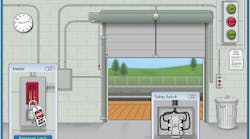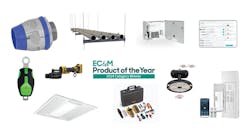Troubleshooting live electrical circuits can pose a hazard not only to the equipment being worked on, but more importantly, to the person performing the labor — especially if that individual lacks experience. To help reduce these risks, Ottawa, Ontario, Canada-based Simutech Multimedia recently released Version 4 of its Troubleshooting Motor Circuits (V4 TMC) training software, a PC-based program that allows users to develop and practice the skills required to repair motor circuits.
“Our V4 TMC software provides users with high-quality hands-on electrical troubleshooting training via realistic electrical simulations,” says Warren Rhude, Simutech Multimedia's president and a former troubleshooting trainer. “This latest edition has been completely redesigned and redeveloped to include comprehensive learning modules, improved simulation capabilities, and an enhanced evaluation system.”
Aimed at anyone who maintains or troubleshoots motor circuits, the software program, which was officially launched on September 15, begins by taking users through a step-by-step learning process. Specifically, students are taught: how 3-phase motors operate and about their winding connections; motor control circuits and the basics of how they operate; how typical motor control components function; skills for diagnosing and troubleshooting motor circuit faults; and the ability to use diagrams to determine how motor circuits work and locate components and connections in all types of electrical equipment.
Once users feel they have a grasp of the basics, they are able to participate in two lab simulations where they learn fundamental motor concepts, such as starting current, locked rotor current, and the effects of varying load. Furthermore, they examine how the components function and learn techniques for finding circuit defects, as well as obtain experience identifying and repairing motor circuit faults.
“The garage door circuit simulation places students in a realistic environment where they use virtual tools such as a multimeter, screwdrivers, and wrenches to pinpoint faults,” explains Rhude. “This allows them to complete all the tasks they would perform if troubleshooting an actual system.”
When performing skill tests, the software grades users on the number of safety errors made, the amount of time taken to solve the problem, what components were replaced, and if the fault repair was successfully completed.
“Streamlined fault evaluation summaries and at-a-glance level evaluation summaries let learners and instructors both track and evaluate progress and discover areas for improvement,” notes Rhude.
It's this feature that most impresses Jim Ramming, chairman for the electrical technology department at Vatterott College located in the greater St. Louis area.
“The product's grading/monitoring capability is very important because I can see, at any time, how any given electrician or prospective electrician is progressing with his or her troubleshooting skills while advancing through the program,” says Ramming, who uses the software to supplement his intensive 10-week electrical troubleshooting class. “I need to be able to see documented results, and this program allows me to do that.”
Other features Ramming finds useful include the enhanced circuit simulations and virtual tools, which he says “keep the electrical students continually engaged and advancing their skills in a manner that we were not able to achieve prior to using this product.”
The software is available in four editions, depending on customer need. The Student and Expert editions are intended for personal use, while the Business and Enterprise editions are suitable for use in the business, industry, and educational sectors. Instructor Resources with the Enterprise Edition include an Administration Program, an Instructors Guide, and Reports. Furthermore, all four editions offer a certificate of completion that can be printed once a user successfully finishes the program.
Pricing for a single copy of the student edition is $79.95, while the expert edition runs $129.95. The Business edition, which is designed for use on a single computer but can track a number of users, costs $395. The Enterprise edition — the company's most comprehensive offering — has a $595 price tag.
For more information, visit www.simutechmultimedia.com.




